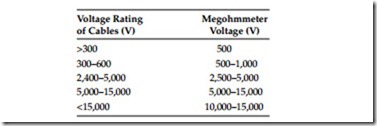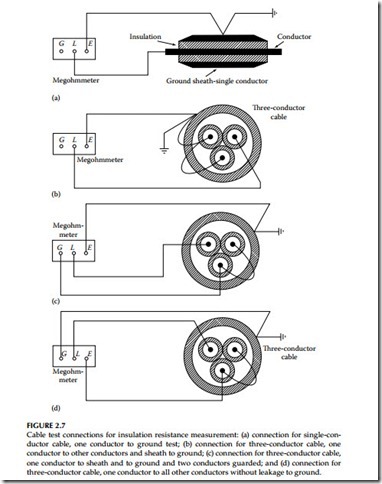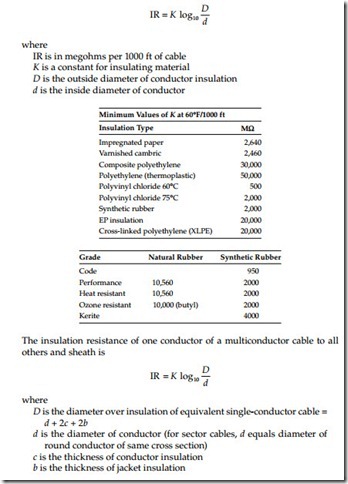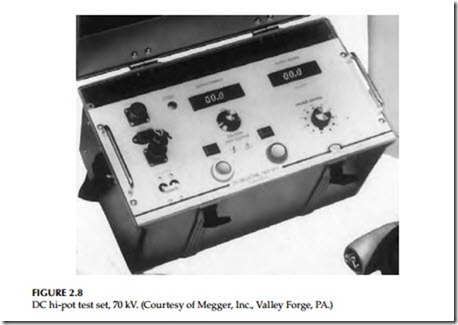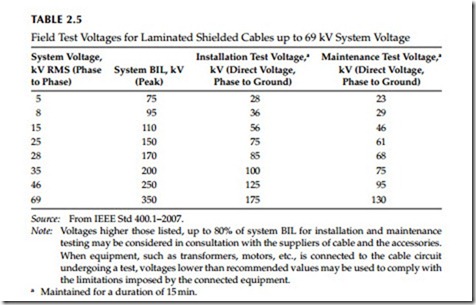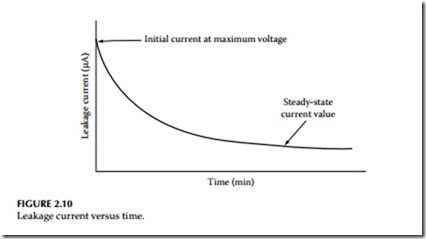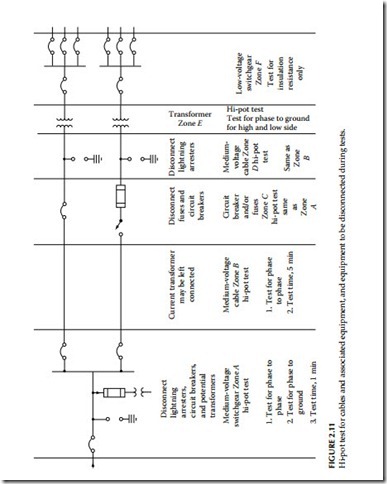Cables and Accessories
Cable testing is conducted to chart the gradual deterioration over the years, to do acceptance testing after installation, for verification of splices and joints, and for special repair testing. Normally, the maintenance proof tests per- formed on cables are at a test voltage of 60% of final factory test voltage. When the exact construction of cable in an existing installation is not known, it is generally recommended that DC maintenance proof test voltage be based on rated AC circuit voltage using the recommended value for the smallest sized conductor in the rated AC voltage range. The DC voltage tests con- ducted on cable are insulation resistance measurement and DC hi-pot test. The DC hi-pot test can be performed as leakage current versus voltage test, leakage current versus time test, or go, no-go overpotential test.
It is always appropriate to conduct the insulation resistance measurement test first, and if data obtained looks good, then proceed with the DC overpotential test. After DC overpotential test is completed, then perform the insu- lation resistance again to assure that the cable has not been damaged during the DC overpotential test.
Insulation Resistance Measurement Test
The insulation resistance is measured using a Megohmmeter (or it can be measured using a portable instrument consisting of a direct voltage source, such as a generator, battery, or rectifier, and a high-range ohmmeter that gives insulation resistance readings in megohms or ohms). This is a nonde- structive method of determining the condition of the cable insulation to check contamination due to moisture, dirt, or carbonization. The insulation resistance measurement method does not give the measure of total dielectric strength of cable insulation or weak spots in the cable. Generally, the follow- ing voltages can be used for the indicated cable voltage rating.
The following is the general procedure when using a megohmmeter (Megger)* for resistance measurement tests.
• Disconnect the cable to be tested from other equipment and circuits to ensure that it is not energized.
• Discharge all stored capacitance in the cable by grounding it before testing, as well as after completing tests.
• Connect the line terminal of the instrument to the conductor to be tested.
• Ground all other conductors together to sheath and to ground.
Connect these to the earth terminal of the test set.
• Similarly measure other insulation resistance values between one con- ductor and all other conductors connected, one conductor to ground and so on. The connections are shown in Figure 2.7a through d.
• The guard terminal of the megohmmeter can be used to eliminate the effects of surface leakage across exposed insulation at the test end of the cable, or both ends of the cable for leakage to ground.
The insulation resistance measurements should be conducted at regular intervals and records kept for comparison purposes. Keep in mind that, for valid comparison, the readings must be corrected to a base temperature, such as 20°C. A continued downward trend is an indication of insulation deterio- ration even though the resistance values measured are above the minimum acceptable limit.
Cable and conductor installations present a wide variation of conditions from the point of view of the resistance of the insulation. These conditions result from the many kinds of insulating materials used, the voltage rating or insulation thickness, and the length of the circuit involved in the measurement. Further- more, such circuits usually extend over great distances, and may be subjected to wide variations in temperature, which will have an effect on the insulation resistance values obtained. The terminals of cables and conductors will also have an effect on the test values unless they are clean and dry, or guarded.
The Insulated Cable Engineers Association (ICEA) gives minimum values of insulation resistance in its specifications for various types of cables and conductors. These minimum values are for new, single-conductor wire
and cable after being subjected to an AC high voltage test and based on a DC test potential of 500 V applied for 1 min at a temperature of 60°F.
These standard minimum insulation resistance (IR) values (for single- conductor cable) are based on the following formula:
Also, the IEEE standard 690-1984* and 422-1986† recommended an insulation resistance field acceptance limit of
In the past, this test has been extensively used for acceptance and maintenance of cables. Recent studies of cable failures indicate that the DC overpotential test may be causing more damage to some cable insulation, such as cross-link polyethylene, than the benefit obtained from such test- ing (see Chapter 6 for more details). It can indicate the relative condition of the insulation at voltages above or near operating levels. This test can be used for identification of weakness in the cable insulation and can also be used to break down an incipient fault. A typical DC test set is shown in Figure 2.8. Generally, it is not recommended that this test be used for breakdown of incipient faults even though some test engineers use it for this purpose. Therefore, the incipient fault breakdown probability should be anticipated before and during the hi-pot test. The impending cable fail- ure will usually be indicated by sudden changes in the leakage current, and before insulation is damaged, the test can be stopped. The test voltage values for DC hi-pot tests are based upon final factory test voltage, which is determined by the type and thickness of insulation, the size of conduc- tors, the construction of cable, and applicable industry standards. The DC test values corresponding to AC factory proof test voltages specified by the industry standards are usually expressed in terms of the ratio of DC to AC voltage for each insulation system. This ratio is designated as K, which when multiplied by the acceptance test factor of 80% and maintenance factor of 60% yields the conversion factors to obtain the DC test voltages for hi-pot tests. These recommended test voltage conversion factors are shown in Table 2.4. Also, the IEEE standard 400.1–2007 lists the voltage values for conducting hi-pot acceptance and maintenance tests in the field for laminated shielded power cables, which are shown in Table 2.5.
Many factors should be considered in selecting the right voltage for existing cables that are in service. As a general rule, for existing cables, the highest values for maintenance should not exceed 60% of final factory test voltage,
and the minimum test value should be not less than the DC equivalent of the AC operating voltage. If the cable cannot be disconnected from all the connected equipment, the test voltage should be reduced to the voltage level of the lowest rated equipment connected. The hi-pot test can be conducted as a step-voltage test as discussed next.
Note: Voltages higher those listed, up to 80% of system BIL for installation and maintenance testing may be considered in consultation with the suppliers of cable and the accessories.
When equipment, such as transformers, motors, etc., is connected to the cable circuit undergoing a test, voltages lower than recommended values may be used to comply with the limitations imposed by the connected equipment.
a Maintained for a duration of 15 min.
Voltage versus Leakage Current Test (Step-Voltage Test)
In this test, the voltage is raised in equal steps and time is allowed between each step for leakage current to become stable. As explained in Chapter 1, the current is relatively high as a voltage is applied owing to capacitance charging current and dielectric absorption currents. As time passes, these transient currents become minimum with the steady-state current remaining, which is the actual leakage current and a very small amount of absorption current. At each step of voltage, the leakage current reading is taken before proceeding to the next step. Usually, it is recommended that at least eight equal steps of voltage be used and at least 1–4 min be allowed between each step. The leakage current versus voltage are then plotted as a curve. As long as this plotted curve is linear for each step, the insulation system is in good condition. At some value of step voltage, if the leakage current begins to increase noticeably, an increase in the slope of the curve will be noticed, as shown in Figure 2.9. If the test is continued beyond this test voltage, the leakage current will increase even more rapidly and immediate breakdown may occur in the cable insulation. Unless breakdown is desired, the test should be stopped as soon as the increase of slope is noticed in the voltage versus leakage current curve.
Maximum leakage current allowable for new cables acceptance can be determined from the ICEA formula for minimum allowable insulation
When the final test voltage of leakage current versus voltage test is reached, it can be left on for at least 5 min, and the leakage current versus time can be plotted for fixed intervals of time as the leakage current during this step reduces from an initial high value to a steady-state value. A curve for good cables will generally indicate a continuous decrease in leakage current with respect to time or steady-state value without any increase of current during the test. This curve is shown in Figure 2.10.
Go, No-Go Overpotential Test
The hi-pot test can be conducted as a go, no-go overpotential test. In this test the voltage is gradually applied to the specified value. The rate of rise of the test voltage is maintained to provide a steady leakage current until final test voltage is reached. Usually, 1–1.5 min is considered sufficient for reaching the final test voltage. The final test voltage can then be held for 5 min, and if there is no abrupt increase in current sufficient to trip the test set, the test has been successfully passed. This test does not provide a thorough analysis of cable condition, but provides sufficient information as to whether the cable meets a specific high-voltage breakdown strength requirement. This type of test is usually performed after installation and repair, where only cable that can withstand strength verification without a breakdown is to be certified.
DC Overpotential Test Connections and Procedures
The test connections for this test are similar to test connections shown in Figure 2.7a, and for three-conductor cable are similar to those shown in Figure 2.7b and c. The test procedures are the following:
• Cable to be tested must be de-energized, opened at both ends, and grounded to discharge any electrostatic charge on the cable. Switches, potential transformers, lightning arresters, jumpers from potheads to feeders, fuses, cutouts, and any switchgear should be discon- nected. If impossible to disconnect any or some of connected equip- ment, the test voltage should not exceed the value that could overstress these devices connected to the cable. See Figure 2.11 for equipment to be disconnected.
• DC test voltage should be applied from phase to ground on each conductor with other conductors, shields, and metallic sheath con- nected to ground or other conductors guarded with shield and metallic sheath grounded.
• Ensure that the hi-pot set main “on–off” switch is in off position and the high-voltage on switch is in the off position with voltage control switch turned to zero position before beginning the tests.
• Connect the hi-pot test set safety ground stud to a good electrical ground and make sure the connections are tight. Never operate the DC hi-pot test set without this ground connection. Also connect the shield ground strap of the shielded cable under test to the test set ground stud.
• Connect the return line from other conductors not under test to the earth ground terminal or to the guard terminal of the test set as desired. The hi-pot grounding switch should be switched into the appropriate position. Normally, 100 V insulation is required on the return line. Connect the shield and sheath to ground and also to the ground terminal of test set. The guard terminal is provided to bypass the current due to corona and surface leakage around the microammeter so that corona and surface leakage cur- rents are not included in the test readings.
• Connect one end of the output or line cable to the desired phase of the cable under test, making sure that the connections are tight and without any sharp edges. Where corona currents may be expected owing to the application of high voltages, it is recommended that the connections be taped, covered over with clear plastic bags, or use a corona ring or corona shield. The other end of the output or line cable is connected to the output or line stud of the test set.
• Cable used for connecting the hi-pot test set to the cable under test, that is, the line or output cable, should be short and direct and supported along its length so that it is not touching the ground or grounding materials or surfaces. If extension cables are to be used with the output or line cable to reach the cable under test, shielded cable should prefer- ably be used for this purpose. The shields of the extension cable and hi-pot cable should be connected with a shield jumper, which should be run away from the splice to prevent leakage. In case of the extension cable being nonshielded, care should be taken to keep the nonshielded wire away from the grounding surfaces as explained previously.
Disconnect lightning arresters, circuit breakers, and potential transformers Medium-voltage switchgear Zone A hi-pot test
1. Test for phase to phase
2. Test for phase to ground
3. Test time, 1 min
• When shielded cable is being tested, it is recommended that the shield be trimmed back about 1 in. for every 10 kV. The shield on the test set end of the cable is connected to ground as explained previously. The shield on the other end of cable can be taped and left hanging without any connections made to it.
• Test set now should be plugged into a 115 V, 60 Hz outlet. It is important that the AC supply voltage have good line regulation, because the DC output voltage of the test set depends upon the AC line input voltage. The test voltage kilovolt range should be selected before beginning the test. The power now can be turned on and the test begun either as step-voltage or as a go, no-go test.
• After the test is completed, turn the high-voltage switch of the test set to off position. Allow the cable just tested to discharge either through the internal test set discharge circuit or external ground applied to the cable by means of hot stick at 2 kV or below. Do not touch the cable until it is fully discharged.
• Connect a ground to the cable that was tested and leave it connected for at least four times the length of the test time or until the cable is connected into the system.
